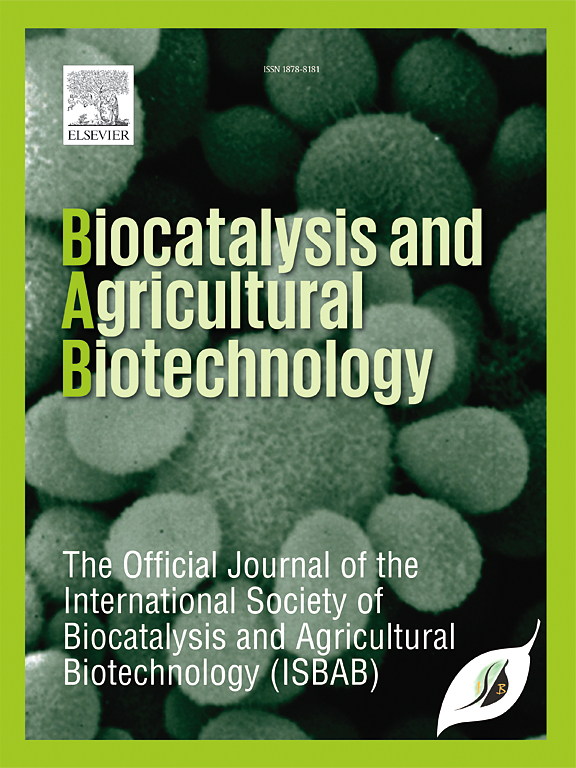Enhancing sustainable sweet grass (Lippia dulcis L.) productivity and essential oil content using sunn hemp (Crotalaria juncea L.) as green manure
IF 3.4
Q2 BIOTECHNOLOGY & APPLIED MICROBIOLOGY
引用次数: 0
Abstract
The application of green manure can sustain biological diversity while maintaining high soil fertility. Therefore, using green manure is a crucial practice for minimizing the environmental and ecological impact of sustainable agricultural development. Lippia dulcis is a medicinal plant used to treat coughs, colds, and bronchitis, as well as having potential antidiabetic and sweetening properties. The aim of the current study is to assess the influence of Crotalaria juncea green manure on Lippia dulcis vegetative growth and essential oil accumulation, as well as on total phenolic compounds and verbascoside levels. The experiment was conducted in the field, based on six treatments, namely: soil and sand substrate (negative control); chemical fertilizer (positive control); as well as 150; 300; 450; and 600 g of green manure in pot 10 L. Dry weights, leaf analysis, photosynthetic pigment levels, total phenolics, total flavonoids, verbascoside, as well as essential oil content, yield and chemical components were assessed. The treatment comprising 600 g of green manure recorded the most significant results for plant biomass. On the other hand, doses of 450 g and 600 g of green manure yielded the best results in terms of essential oil content and yield. In contrast, the control treatment recorded the best results for verbascoside and total flavonoids. Chemical fertilizer and 300 g green manure were the treatments that recorded the most efficient results for phenolic compounds. Using green manure instead of conventional fertilization had a positive influence on the attributes analyzed in the species Lippia dulcis, and it is a cheaper and more sustainable strategy for growing medicinal plants.

以大麻(Crotalaria juncea L.)为绿肥提高可持续香草(Lippia dulcis L.)产量和精油含量
施用绿肥可以在保持土壤肥力的同时维持生物多样性。因此,使用绿肥是减少农业可持续发展对环境和生态影响的关键做法。Lippia dulcis是一种药用植物,用于治疗咳嗽,感冒和支气管炎,以及具有潜在的抗糖尿病和甜味特性。本研究旨在探讨芥菜绿肥对芦笋营养生长和精油积累的影响,以及对芦笋总酚类化合物和毛蕊花苷含量的影响。试验在田间进行,采用6个处理,分别为:土砂基质(阴性对照);化肥(阳性对照);以及150;300年;450年;测定干重、叶片分析、光合色素水平、总酚类物质、总黄酮、毛蕊花苷、挥发油含量、产量和化学成分。600克绿肥处理对植物生物量的影响最为显著。另一方面,450克和600克绿肥的剂量在精油含量和产量方面产生了最好的结果。对照处理的毛蕊花苷和总黄酮含量最高。化学肥料和300克绿肥处理对酚类化合物的处理效果最好。绿肥替代传统施肥对药用植物Lippia dulcis的性状有积极影响,是一种更经济、更可持续的药用植物种植策略。
本文章由计算机程序翻译,如有差异,请以英文原文为准。
求助全文
约1分钟内获得全文
求助全文
来源期刊

Biocatalysis and agricultural biotechnology
Agricultural and Biological Sciences-Agronomy and Crop Science
CiteScore
7.70
自引率
2.50%
发文量
308
审稿时长
48 days
期刊介绍:
Biocatalysis and Agricultural Biotechnology is the official journal of the International Society of Biocatalysis and Agricultural Biotechnology (ISBAB). The journal publishes high quality articles especially in the science and technology of biocatalysis, bioprocesses, agricultural biotechnology, biomedical biotechnology, and, if appropriate, from other related areas of biotechnology. The journal will publish peer-reviewed basic and applied research papers, authoritative reviews, and feature articles. The scope of the journal encompasses the research, industrial, and commercial aspects of biotechnology, including the areas of: biocatalysis; bioprocesses; food and agriculture; genetic engineering; molecular biology; healthcare and pharmaceuticals; biofuels; genomics; nanotechnology; environment and biodiversity; and bioremediation.
 求助内容:
求助内容: 应助结果提醒方式:
应助结果提醒方式:


